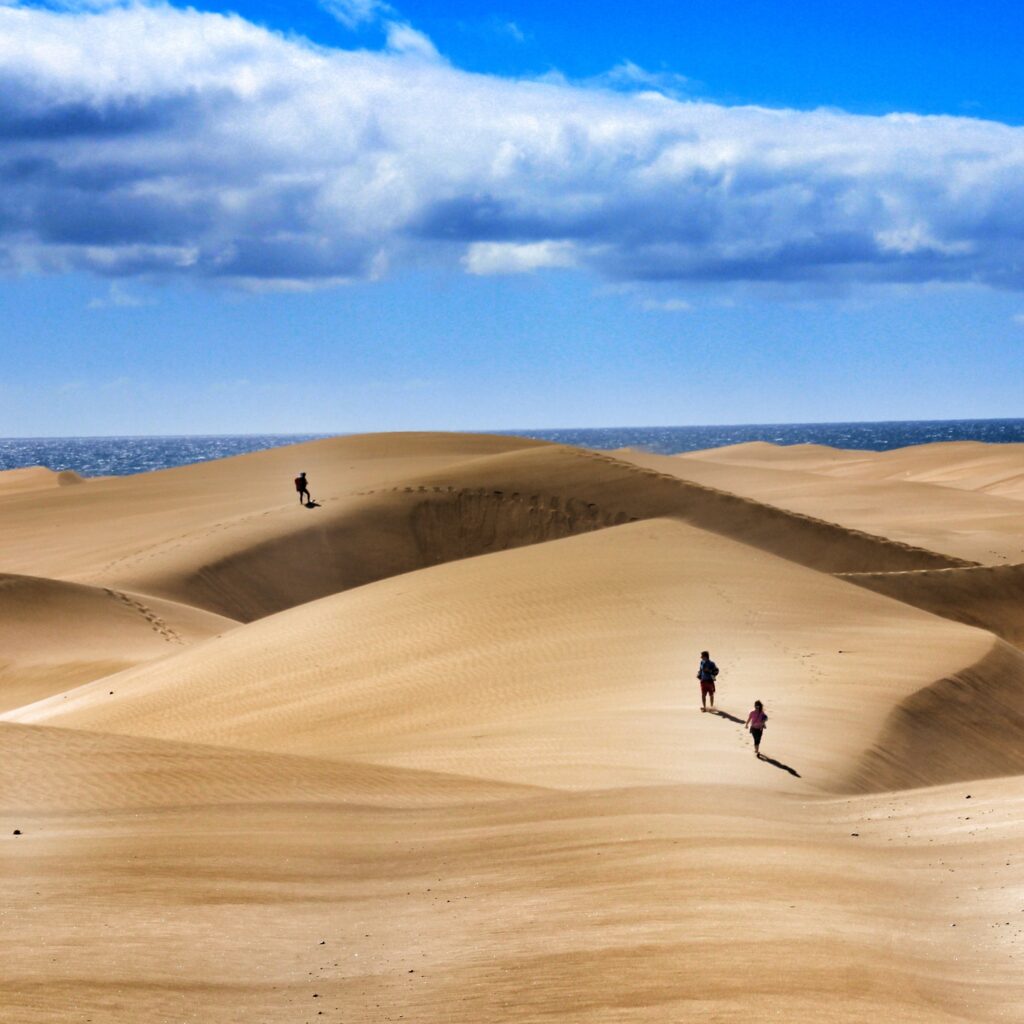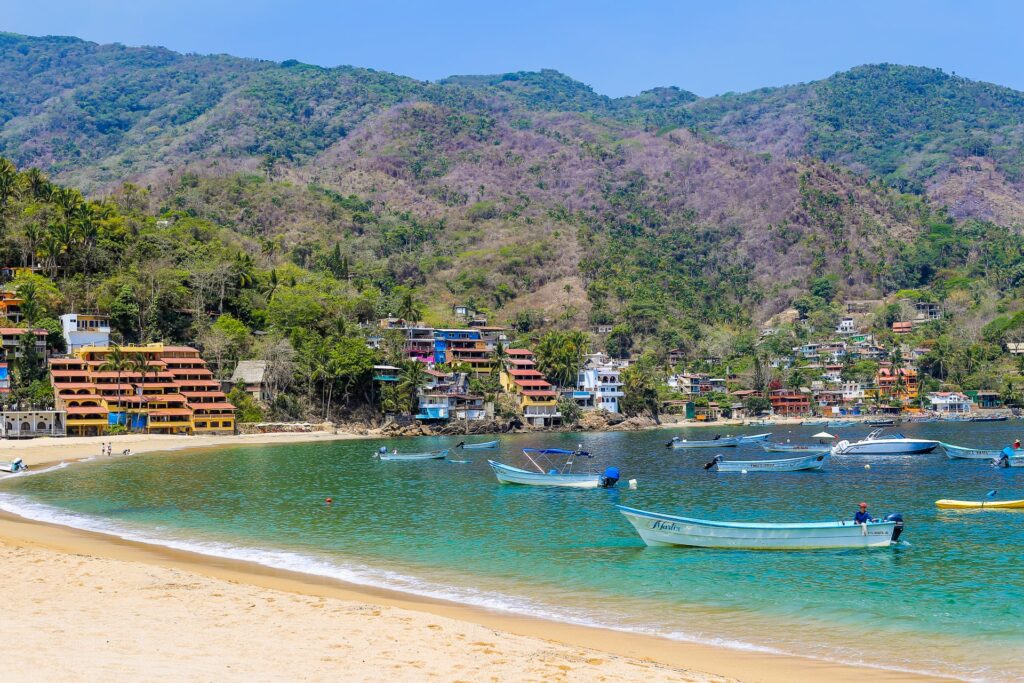Certainly! Here are some hidden gems and off-the-beaten-path attractions in various countries and regions around the world:
1.Iceland

- Hengifoss: Hengifoss is a waterfall located in the eastern part of Iceland, near the town of Egilsstadir. It is one of the country’s most famous and picturesque waterfalls, known for its stunning beauty and unique geological features.Hengifoss is situated in the eastern region of Iceland, specifically in the municipality of Foetal district .The waterfall is about 35 kilometers southwest of the town of Egilsstadir. Hengifoss is renowned for its impressive height, standing at approximately 128 meters (420 feet). It is one of the tallest waterfalls in Iceland. The waterfall is surrounded by colorful rock formations, with distinctive red and black layers of basalt columns and clay. The vibrant colors of the rocks add to the visual appeal of Hengifoss and make it a popular destination for photographers and nature enthusiasts.

- Drangey Island:
Drangey is a small, steep-sided island located off the coast of northern Iceland in the skegaphajoridur phajord near the town of Sheep ear hook in northern Iceland. The island is of volcanic origin, characterized by towering cliffs that rise abruptly from the sea. It is a result of ancient volcanic activity Drangey is a significant bird sanctuary, hosting a variety of seabirds, including puffins, guillemots, and kittiwakes. The island provides crucial nesting grounds for these species. Access to Drangey is possible only by boat, and visitors often take boat tours from the mainland to reach the island. The journey offers scenic views of the surrounding coastline
2. Portugal

- Sintra: Sintra is a picturesque town nestled within the lush hills of the Serra de Sintra, located just outside of Lisbon, Portugal. Renowned for its romantic and fairy-tale-like atmosphere, Sintra has been designated as a UNESCO World Heritage Site for its cultural landscape. The town is adorned with colorful palaces, opulent mansions, and enchanting gardens that showcase a blend of architectural styles, including Moorish, Gothic, and Manueline. One of the most iconic landmarks is the Pena Palace, an eclectic and vibrant castle perched atop a hill, offering panoramic views of the surrounding countryside. The Moorish Castle, another historic gem, stands as a testament to the region’s rich history. The narrow, winding streets of Sintra’s historic center are lined with charming cafes, artisan shops, and centuries-old houses, creating an idyllic setting for exploration.

- monsaraz:
Monsaraz is a captivating medieval village perched on a hilltop in the Alentejo region of Portugal. Steeped in history and surrounded by fortified walls, Monsaraz offers a glimpse into the country’s past with its well-preserved cobblestone streets and medieval architecture. The village enjoys a strategic position overlooking the vast Alqueva reservoir, providing stunning panoramic views of the surrounding countryside. Visitors can explore the charming castle, which dates back to the 13th century, and the equally impressive Igreja Matriz, a whitewashed church at the heart of the village. The narrow alleys are lined with traditional houses adorned with colorful flowers, creating a quaint and timeless atmosphere. Monsaraz is renowned for its enchanting sunsets, attracting photographers and romantics alike to witness the changing colors over the Alentejo plains.
3. Japan

- Tottori Sand Dunes:
Tottori Sand Dunes, located in Tottori Prefecture along the Sea of Japan, is a captivating natural wonder renowned for its vast expanses of wind-sculpted sand. Covering approximately 16 kilometers of coastline, these dunes are the largest in Japan, reaching heights of up to 50 meters. The landscape is ever-changing due to the constant influence of wind and weather, creating undulating patterns and distinctive shapes in the sand. Visitors can enjoy activities such as sandboarding and camel rides, adding a recreational element to the unique experience of exploring the dunes. The Tottori Sand Museum, situated at the edge of the dunes, showcases intricate sand sculptures created by artists from around the world, further enhancing the cultural and artistic appeal of the area

- Nagoro:
Nagoro is a remote village in the Tokushima Prefecture of Japan, known for its unusual and somewhat eerie population – thousands of life-sized dolls that outnumber the living inhabitants. Created by local artist Ayano Tsukimi, these dolls, known as “kakashi,” are scattered throughout the village, populating fields, roads, and even abandoned buildings. The dolls represent a diverse array of characters, from schoolchildren to farmers, reflecting the memories and personalities of those who once lived in Nagoro. Many of the dolls wear old clothing donated by locals, adding a personal touch to each creation. The village itself has a tranquil and somewhat surreal atmosphere as visitors wander through the quiet streets, encountering these silent and expressionless figures.
4. New Zealand

- Tongariro Alpine Crossing:
The Tongariro Alpine Crossing is a world-renowned hiking trail situated in the Tongariro National Park, New Zealand. Widely regarded as one of the best day hikes globally, this 19.4-kilometer trail traverses diverse landscapes, including volcanic craters, emerald lakes, alpine meadows, and lunar-like terrains. The highlight of the trek is the stunning views of Mount Ngauruhoe, which portrayed Mount Doom in the Lord of the Rings film trilogy. The challenging hike involves steep ascents and descents, reaching an elevation of 1,886 meters at the Red Crater. Hikers also pass by the vividly colored Emerald Lakes, adding to the trail’s visual appeal. The ever-changing weather conditions can make the Crossing challenging, and proper preparation is essential. Despite the difficulty, the Tongariro Alpine Crossing provides a truly immersive and breathtaking experience, attracting adventure seekers and nature enthusiasts from around the world.

- Nugget point:
Nugget Point is a scenic headland located on the southeastern coast of the South Island of New Zealand, renowned for its dramatic coastal views and unique rock formations. Jutting out into the Pacific Ocean, Nugget Point is named after the rocky islets, or “nuggets,” scattered off its shores. The iconic lighthouse perched on the headland adds to the area’s charm and serves as a historic landmark. The viewpoints along the coastal walkway offer breathtaking panoramas of the surrounding cliffs, wildlife, and the turbulent sea. The location is particularly known for its abundant birdlife, including colonies of seals and sea lions. The coastal track provides an opportunity to witness the diverse marine ecosystem and the rugged beauty of the Otago coastline, making Nugget Point a must-visit destination for nature lovers and photographers exploring the stunning landscapes of New Zealand.
5. Mexico

- Yelapa:
Yelapa is a hidden gem nestled along the Pacific coast of Mexico, accessible only by boat, making it a secluded paradise that captivates visitors with its natural beauty. Situated in the Bay of Banderas, near Puerto Vallarta, Yelapa boasts pristine beaches, lush jungles, and a serene atmosphere. The village is known for its laid-back charm, where cobblestone streets wind through small, colorful homes. Visitors can explore the cascading Yelapa Waterfall, a refreshing natural attraction tucked into the tropical landscape. The beachfront is dotted with palapa-roofed restaurants serving fresh seafood, offering a taste of local cuisine against the backdrop of the azure sea. Yelapa provides a tranquil escape from the bustling city life, attracting those seeking a peaceful retreat, where the only sounds are the gentle lapping of waves and the rustling of palm leaves in the breeze.

- Hierve el Agua:
Hierve el Agua, located in the Oaxaca region of Mexico, is a mesmerizing natural attraction known for its unique petrified waterfall formations and mineral-rich springs. The name translates to “boiling water,” although the pools are not actually hot springs. The site features stunning limestone formations that resemble cascading waterfalls, created over thousands of years by the minerals deposited from the spring waters. Visitors can take a dip in the naturally formed pools, enjoying panoramic views of the surrounding mountains and valleys. The landscape is dotted with terraced basins filled with turquoise-blue water, creating a surreal and otherworldly ambiance. Hierve el Agua is also rich in cultural significance, with archaeological remnants nearby, showcasing the historical importance of the site to ancient civilizations. The journey to Hierve el Agua is an adventure.
6. Morocco

- Chefchaouen:
Chefchaouen, often referred to as the “Blue Pearl” of Morocco, is a captivating mountain town renowned for its distinctive azure-colored buildings that cascade down the Rif Mountains. Nestled in the northwest of the country, Chefchaouen’s narrow winding streets are adorned with various shades of blue, creating a surreal and picturesque environment. The town’s unique color scheme is believed to have spiritual and aesthetic significance for the local population. Beyond its enchanting blue palette, Chefchaouen is celebrated for its vibrant markets, offering a variety of handcrafted goods, including intricate textiles and pottery. The central Plaza Uta el-Hammam is a lively hub with cafes and shops, providing a perfect spot to soak in the local atmosphere. The surrounding landscapes offer opportunities for hiking, providing panoramic views of the town and the lush greenery of the mountains.

- Merzouga:
Merzouga, situated in the southeastern part of Morocco, is a small village that serves as the gateway to the mesmerizing Sahara Desert. Renowned for its vast expanses of golden sand dunes, Merzouga is a haven for those seeking an authentic desert experience. The towering Erg Chebbi dunes, reaching heights of up to 150 meters, dominate the landscape, creating a stunning backdrop for visitors. Camel treks into the dunes at sunrise or sunset are a popular activity, providing an opportunity to witness the ever-changing colors of the desert sky. Visitors can also spend a night in a traditional Berber desert camp, immersing themselves in the serene silence of the Sahara under a canopy of stars.
7. Australia
- kangaroo island:

Kangaroo Island, located off the southern coast of Australia, is a nature lover’s paradise renowned for its diverse wildlife, pristine landscapes, and rugged coastlines. Accessible by a short ferry ride from the South Australian mainland, the island is a sanctuary for native Australian fauna, including kangaroos, koalas, sea lions, and a variety of bird species. Flanked by stunning beaches and characterized by soaring cliffs, the coastline offers breathtaking vistas and opportunities for wildlife encounters. Remarkable Rocks and Admirals Arch are iconic geological formations sculpted by nature over millennia, adding to the island’s allure. The island’s commitment to conservation is evident in its protected areas, such as Flinders Chase National Park, where visitors can explore the untouched beauty of native flora and fauna.

- Wave Rock:
Wave Rock is a natural rock formation located near the town of Hyden in Western Australia, captivating visitors with its unique surfboard-shaped appearance. Standing at about 15 meters in height and stretching for over 100 meters in length, the granite rock’s distinct wave-like shape is a result of weathering and erosion over millions of years. The rock’s rounded crest gives the illusion of a giant breaking wave frozen in time. The site is not only a geological marvel but also culturally significant, with ancient Aboriginal rock paintings found in the surrounding area. Visitors to Wave Rock can explore the nearby Hyden Wildlife Park and marvel at the diverse flora and fauna of the region.

8. Greece
- Meteora:
Meteora, a UNESCO World Heritage site in central Greece, is renowned for its striking rock formations crowned with monasteries. The name “Meteora” translates to “suspended in the air,” perfectly capturing the essence of these towering sandstone pillars. Perched atop these sheer cliffs, the monasteries were built by monks seeking isolation and spiritual retreat starting in the 14th century. Today, six monasteries remain, providing breathtaking panoramic views of the surrounding landscape. Accessible by stone staircases and pathways, the monasteries house religious artifacts, frescoes, and offer a glimpse into the history of Byzantine monasticism. The stunning rock pillars, rising dramatically from the Thessalian plain, create a surreal and awe-inspiring landscape, attracting both religious pilgrims and curious travelers to witness the harmonious convergence of nature and human architecture in this unique region of Greece.

- Matala:
Matala, located on the southern coast of Crete in Greece, is a charming seaside village known for its unique landscape and historical significance. Famous for its artificial caves carved into the cliffs, Matala gained international attention during the 1960s and 1970s when it became a haven for hippies seeking a bohemian lifestyle. The caves, originally carved by the Romans and later used as tombs, now serve as a symbol of the village’s eclectic past. Matala’s pristine sandy beaches and crystal-clear waters make it an ideal destination for sun-seekers, while the laid-back atmosphere and waterfront tavernas contribute to its appeal. The village is surrounded by picturesque landscapes, and the nearby archaeological site of Phaistos adds a cultural touch to the area.
9. Brazil

- Lençóis Maranhenses:
Lençóis Maranhenses is a mesmerizing natural wonder located in the state of Maranhão, Brazil. This unique landscape features expansive sand dunes stretching as far as the eye can see, interrupted by stunning freshwater lagoons during the rainy season. The dunes, which can reach heights of 40 meters, create an otherworldly and ever-shifting terrain that contrasts beautifully with the azure skies. The park is a haven for nature enthusiasts, offering the chance to explore the vast sand formations and take refreshing dips in the clear lagoons, creating a harmonious blend of desert and oasis. The most popular time to visit is from June to September when the lagoons are at their fullest. Lençóis Maranhenses is a testament to the raw beauty of nature, attracting travelers with its surreal landscapes and a unique combination of sand and water.

- chapada dos:
Chapada dos Veadeiros, situated in the Brazilian state of Goiás, is a breathtaking national park renowned for its striking landscapes and rich biodiversity. The park encompasses high plateaus, deep canyons, crystal-clear rivers, and waterfalls, creating a haven for nature lovers and adventure seekers. The park’s centerpiece is the impressive Vale da Lua (Valley of the Moon), characterized by surreal rock formations shaped by the flowing waters of the São Miguel River. Visitors can explore a variety of hiking trails that lead to scenic viewpoints, such as the breathtaking Mirante da Janela, offering panoramic vistas of the expansive wilderness. Chapada dos Veadeiros is also a UNESCO World Heritage site, recognized for its diverse flora and fauna, including rare and endemic species. The park’s pristine natural beauty, combined with its ecological importance, makes it a popular destination for those seeking an immersive experience in Brazil’s captivating wilderness.
10. Canada

- Gros Morne National Park:
Gros Morne National Park, located on the west coast of Newfoundland in Canada, is a UNESCO World Heritage Site celebrated for its dramatic landscapes and geological wonders. The park showcases towering cliffs, deep fjords, and a variety of ecosystems, including dense forests and alpine plateaus. The iconic Gros Morne Mountain, standing at 806 meters, dominates the skyline and offers challenging hiking trails with rewarding panoramic views. The park is home to diverse wildlife, including moose, black bears, and a variety of bird species. The coastal cliffs, such as those at Western Brook Pond, feature impressive waterfalls and boat tours through this glacially-carved fjord. With its mix of stunning scenery, geological significance, and outdoor recreation opportunities, Gros Morne National Park is a haven for hikers, nature enthusiasts, and those seeking to explore the wonders of Canada’s natural heritage.

- churchil:
Churchill, situated on the western shore of Hudson Bay in Manitoba, Canada, is a unique town known for its remarkable wildlife encounters and subarctic climate. Often referred to as the “Polar Bear Capital of the World,” Churchill attracts visitors eager to witness the annual migration of polar bears as they move from the tundra to the sea ice. Additionally, the town is a prime location for observing beluga whales in the summer months. Beyond its wildlife appeal, Churchill offers a rich cultural experience, with a history shaped by Indigenous communities, fur trading, and northern exploration. The town is also famous for its vibrant northern lights displays during the winter, adding an extra layer of allure for those seeking a true Arctic adventure.
conclusion
These hidden gems offer unique experiences and a chance to explore lesser-known aspects of their respective countries and regions. Remember to check local regulations and conditions before visiting these places, as some may require special permits or have seasonal restrictions.




